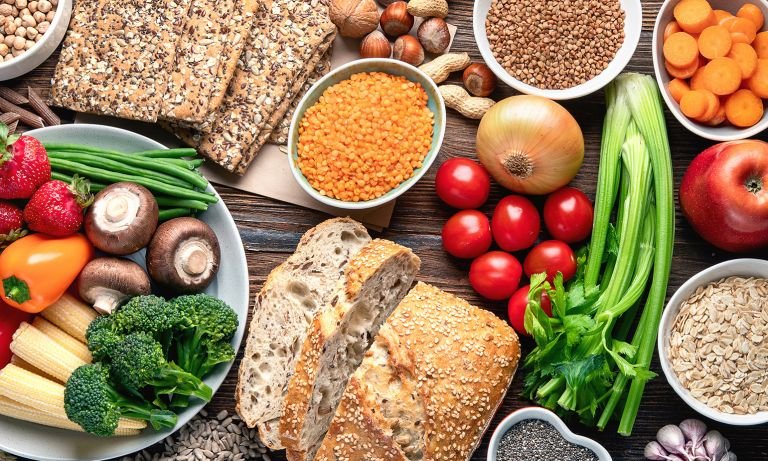The word ‘fiber’ can be used interchangeably with dietary fiber to describe a large group of nutrients that exist only in plant-based food sources. These foods that are high in fiber can be very beneficial to your health.
This article discusses the benefits of eating fiber-rich foods, how they work and why you should eat them.
You’ll learn about different types of fiber-rich foods, sources for these fibers, their role in weight loss and disease recovery. We will also touch upon their side effects and nutritionists’ opinions on these foods.
Contents
- 1 What Is Fiber?
- 2 How Does Fiber-Rich Food Works?
- 3 Why You Should Eat Fiber-Rich Foods?
- 4 Types Of Fiber-Rich Foods
- 5 Sources Of Fiber-Rich Foods
- 6 Top Benefits Of Fiber-Rich Foods
- 7 Fiber-Rich Foods And Weight Loss
- 8 Fiber-Rich Foods And Disease Prevention & Recovery
- 9 Side Effects Of Fiber-Rich Foods
- 10 Nutritionists And Dieticians On Fiber-Rich Foods
- 11 Conclusion
What Is Fiber?
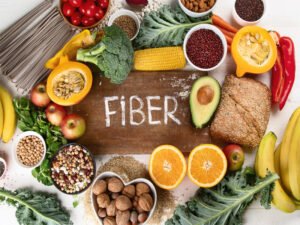
Fiber is often called “roughage” or insoluble fiber. It’s the part of plant foods our body can’t digest. It helps make us feel full faster and for longer periods. This is how it helps with weight loss.
Fiber also plays a role in regulating blood sugar levels, keeping your bowels regular (making it easier to avoid constipation), and helping to prevent certain diseases.
How Does Fiber-Rich Food Works?
The benefits of eating plenty of fiber are well-established, but understanding why can be confusing. Believe it or not but many scientists are still trying to understand how fiber-rich foods work in our bodies.
We know this much for now that the bacteria in your gut help ferment (digest) some types of dietary fiber. These bacteria overall bring changes in how they affect your health and weight loss efforts.
Why You Should Eat Fiber-Rich Foods?
Eating fiber-rich foods such as whole fruits, vegetables, legumes, nuts, and seeds is an easy way to increase the amount of filling, nutritious food in your diet. Thus, it is a great alternative for people who are trying to lose weight or prevent chronic diseases like diabetes and heart disease.
NOTE: Recommended levels range between 25 to 30 grams for women and 38 grams for men.
Types Of Fiber-Rich Foods
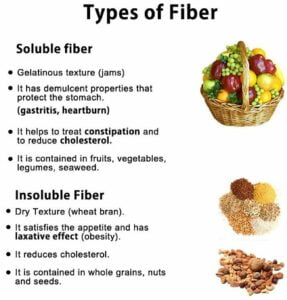
There are two main types of fiber:
- Soluble
- Insoluble
Soluble fibers dissolve in water, while insoluble (or “roughage”) does not. Both forms provide health benefits when consumed regularly as part of a healthy diet or lifestyle routine. Some foods contain both soluble and insoluble fibers, but most foods contain one or the other.
Functions Of Soluble And Insoluble Fiber
Soluble fibers attract water to form a thick gel which is slowly digested by your body. This type of fiber has been shown to significantly help control blood glucose levels and lower blood cholesterol levels.
Insoluble fibers have no impact on how quickly your body digests foods which means they don’t affect blood sugar or cholesterol levels. But there is a lot of evidence that eating insoluble fiber can help prevent constipation. They also promote bowel regularity by softening stools so they move more easily through the colon.
Main Dietary Sources Of Soluble Fiber
- Fruits with edible skin and seeds such as apples, oranges, strawberries, and plums.
- Citrus fruits like grapefruit are also good sources of soluble fiber if you eat the white inner pulp (albedo). Soluble fiber from whole fruit averages around two grams per serving.
- Vegetables such as carrots, zucchini, and potatoes are also excellent sources of soluble fiber if you eat the skin along with the flesh. The outermost layer (peel) is a source of insoluble fiber while the inner yellow or orange flesh area has more soluble fiber.
Main Dietary Sources Of Insoluble Fiber
- Whole-wheat flour, whole oatmeal, wheat bran, and other unprocessed grains are excellent sources of insoluble fiber.
- Dried peas and beans (not canned) like lentils, black beans, or kidney beans contain high amounts of both soluble and insoluble dietary fibers.
- Whole-wheat bread is also a good source of insoluble fiber.
Sources Of Fiber-Rich Foods
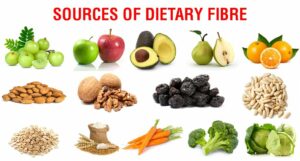
Fibers are found in vegetables as well as grains. The important sources of dietary fiber include fruits, pulses, whole cereals, and bran. There is also a small amount of fiber present naturally in meat and dairy products but it can be acquired from plant-based food sources only. Some of the types of fiber-rich food include:
Vegetables and fruits
These foods contain both soluble as well as insoluble fiber. Fibers present in vegetables help to control blood sugar levels, prevent constipation, and also lower cholesterol levels. Soluble fibers found in fruit reduce serum cholesterol levels by trapping bile acids secreted from the liver.
Pulses
Pulses like peas, beans, and lentils are fiber-rich food items that help in lowering blood sugar levels as well as cholesterol levels. They also prevent constipation and promote healthy bowel movement by increasing the digestive health of the body. These types of food contain both soluble as well as insoluble fiber with a high amount of protein.
Whole cereals
Whole grains are a good source of dietary fiber that can be found in bran, oatmeal, and brown rice. The soluble fiber present in it helps to lower blood cholesterol levels as well as maintain the healthy digestive system by improving bowel movement. It also reduces the risk of heart diseases, diabetes, and obesity.
Bran
Bran is the outer layer of grains that are rich in fiber content. It helps to keep cholesterol levels under control by absorbing bile acids secreted from the liver. Fiber present in bran also prevents constipation, helps bowel movement, and maintains a healthy digestive system. Whole wheat bread is a good source of dietary fiber.
Nuts and Seeds
Nuts like almonds, cashew nuts, etc. are rich in fiber content that help to reduce weight by controlling blood sugar levels present in the body. They also control cholesterol levels, prevent heart diseases and improve bowel movement regularly. The fiber found in seeds helps to keep bowel movements regular without giving any discomfort while passing stool.
Minerals
Minerals are also found in fiber-rich foods that help to improve the digestive system. Calcium is one of them which can be obtained from milk, but one should avoid intake of excess calcium as it may have negative effects on health. Iron present in red meat helps to carry oxygen throughout the body and prevent anemia.
Meat and dairy products
The fiber content in meat is little as compared to plant-based food sources. But some types of meat like kidneys contain a high amount of fiber that helps to lower cholesterol levels. Dairy products like milk and yogurt are a good source of calcium which can prevent osteoporosis (a condition where bones become weak).
Top Benefits Of Fiber-Rich Foods

These are some reasons why you should eat more fiber:
- Aids In Digestion – Fiber helps your gastrointestinal system by adding bulk to stools. It prevents constipation and straining during bowel movements.
- Lower LDL cholesterol – Studies show that eating fiber reduces low-density lipoprotein (LDL) cholesterol by up to 13%.
- Slows the absorption of sugars and reduces insulin levels– This mechanism becomes a great boon for people with diabetes or at risk for developing type-two diabetes.
- Help you lose weight or maintain healthy body weight – People who eat plenty of high-fiber foods often feel fuller for longer. This satiety may be related to the gel-forming properties of soluble fiber. It slows digestion and absorption in your small intestine.
- Reduced incidence of cholesterol cancer – Studies show that eating more than 30 grams of dietary fiber reduces the risk of colorectal cancer by 40% to 50%.
- Reduced disease Risk – Fiber-Rich Foods also reduce the risk of heart disease, stroke, and high blood pressure.
Fiber-Rich Foods And Weight Loss
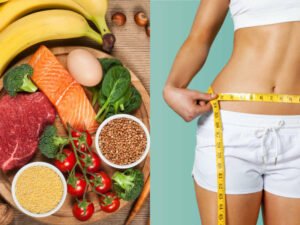
Now let us understand that how fiber is also important for weight loss.
- Fibers also act as great appetite suppressants. Because they absorb water and swell up in the stomach, physically stretching it out creating a feeling of fullness. This way it helps to prevent overeating.
- Fibers delay the emptying of stomach contents into the small intestine leading to prolonged satiety.
- Fibers slow down digestion, thus, slowing down carbohydrate absorption. This keeps us feeling satisfied for longer periods which can be helpful in weight loss strategies.
To put it simply, these foods play a critical role in maintaining good health. As they help reduce appetite as well as decrease calorie intake throughout the day. They aid the weight loss process as they increase satiety without adding extra calories and even boost metabolism.
NOTE: A study shows that a high fiber diet can reduce calorie intake by up to 20%.
Fiber-Rich Foods And Disease Prevention & Recovery
- Maintain digestive health: Fibers are key in the maintenance and regulation of blood sugar levels, bowel motility or movement (prevent constipation), and even lowering cholesterol levels.
- Aid in bowel disorders: Fibrous foods contain soluble fiber which absorbs water as it passes through your system. This action helps soften stools so they move more easily through the colon. This helps prevent constipation and hemorrhoids. This is why fiber-rich foods are so important for anyone with bowel disorders.
- Reduce the risk of heart diseases: Fibers also help to reduce blood cholesterol levels by binding together with bile acids (which contain fat). So they can be excreted from our body rather than reabsorbed back into the body. This helps lower blood cholesterol levels and reduces your risk of heart disease or stroke.
- Help in cutting intake of sugary foods: Some fibers also absorb sugar (sucrose) molecules into their structure. It means they take longer for your body to digest. This is helpful because if you eat sugary foods slowly over time, you will not get cravings for more sugary foods.
NOTE: The key here is not just adding fiber-rich foods into your diet. But increasing the amount of fiber in your daily food intake while maintaining an adequate calorie count on top of it all.
Side Effects Of Fiber-Rich Foods
There are a couple of side effects caused by fiber-rich foods. These may vary from person to person.
They depend on the type of food being consumed, the amount being consumed, and how quickly it is introduced into your diet after you have been eating a low-fiber or no-fiber diet.
Bloating
One possible side effect includes bloating. Bloating is caused when the foods are high in fiber. Because it absorbs water and forms a gel that will bulk up inside your stomach. It makes you feel bloated or full quickly after eating even small amounts of food.
Measure: This can be counteracted by having smaller meals more frequently throughout the day instead of fewer larger meals.
Diarrhea
Another possible side effect includes loose stools or diarrhea. This may occur when you increase your fiber-rich food too quickly without increasing the amount of water that is consumed at the same time.
Measure: Introducing more liquids will help to counter this side effect. They allow bulkier types of fibers easier to pass through the large intestine before they can absorb all the liquid in the bowel which can lead to loose stools.
Nutritionists And Dieticians On Fiber-Rich Foods
The American Dietetic Association recommends that every individual should aim to eat high-fiber foods in their daily diet. While giving a general list of such food, they also add that one must not be dependent on only the commercial products. Instead, try to include as many natural sources of fibers. Such as fresh fruits, vegetables, whole grains, etc. into one’s daily meal plan.
Nutritionists agree with this statement and believe that everyone should know the sources of fiber-rich foods and how they can be included in their regular diet. They recommend high fiber food like oats and other wholegrain cereals, whole fruit & vegetables, and especially fresh juice made from these.
Conclusion
To sum it up, fiber-rich foods are important to maintain a healthy digestive system. They also help your body remove toxins that can build up if you don’t get enough of them. Fiber helps regulate blood sugar levels and keeps hunger at bay by slowing down the rate at which food leaves the stomach so you feel full longer. So eat more fruits, vegetables, beans, whole grains, and nuts for optimal health!
Consider contacting Mantra Care for additional information on nutrition. You can also get in touch with their nutrition experts through our online nutrition counseling, who can guide you through the process and help you achieve your fitness goals. Download our Fitness App to know more about us.
